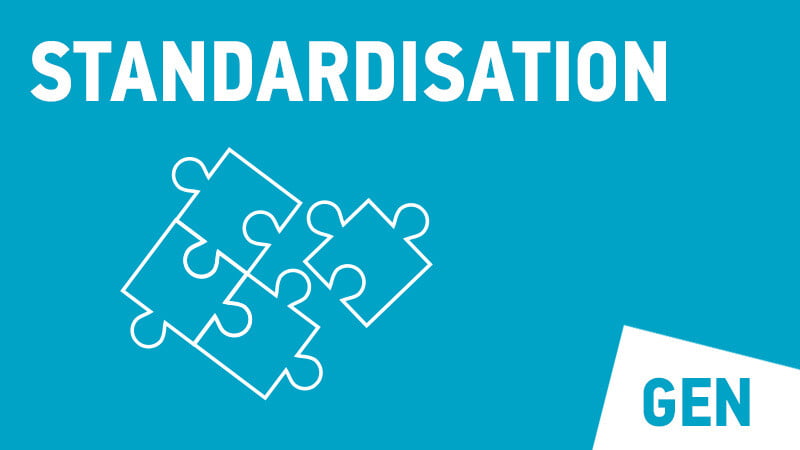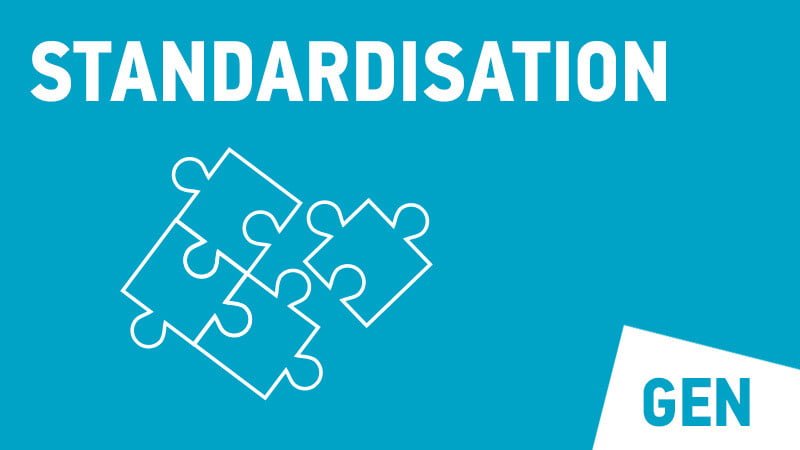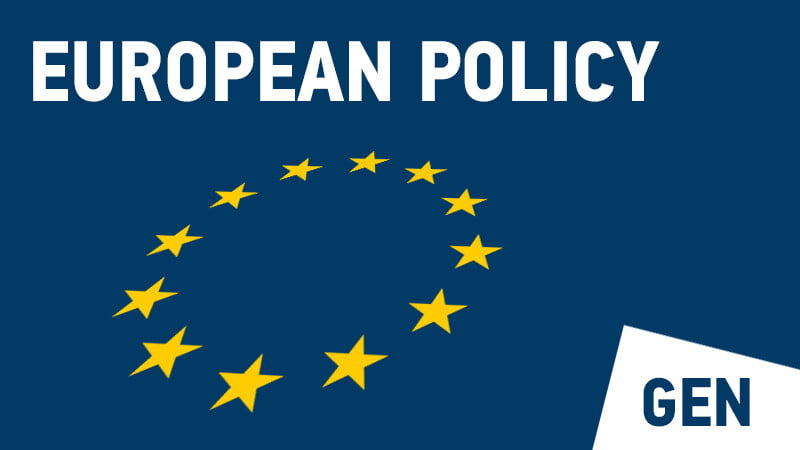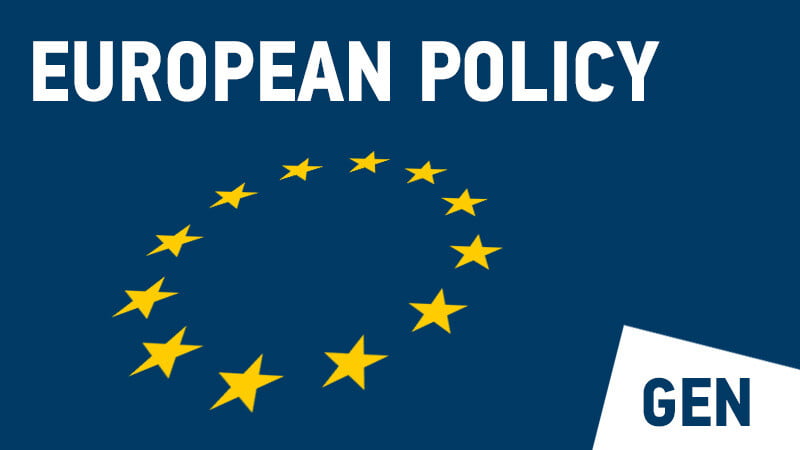GEN – 1482.00. In cooperation with Orgalim, the Eurovent Team provides you with an overview on all European legislative developments of relevance to the HVACR sector. The Bulletin provides a compendium allowing the industry to assess the status quo.
Highlights
Construction Products Regulation (CPR)
The Internal Market Committee (IMCO) of the European Parliament voted on its draft report on 23 May 2023. Prior to the vote, the consideration of the compromise amendments took place in an IMCO meeting on 25 April. Around 1000 amendments were tabled to the Commission’s proposal. The Rapporteur (Christian Doleschal: EPP, Germany) and Shadow Rapporteurs worked on 17 compromise amendments. These compromises cover the scope as well as the way in which standardisation is to be achieved in relation to construction products. The compromises also address green public procurement, Member States’ incentives, and technical elements, such as the repeal of the current Construction Products Regulation and arrangements for the transition between the two regimes.
At the same time, the opinion report from the ITRE Committee was published on 3 May. The opinion Rapporteur (Pascal Arimont: EPP, Belgium) highlighted the need to set out a clear set of rules for the standardisation process, to ensure legal clarity and the harmonisation of standards. He stressed that Member States should have the possibility to exempt remanufactured products from the obligation to draw up a declaration of performance. Furthermore, he proposed improving the information on the environmental performances of construction products and supported the digitalisation of information and documentation.
In parallel, the Working Party on Technical Harmonisation (Construction Products) continued the examination of the Swedish Presidency compromise proposal in its latest meetings on 30 March, 18 April and 8 May. The next meeting is scheduled for 26 May.
As for the next steps, the plenary vote on the CPR report is tentatively planned to take place on 10 July. Inter-institutional negotiations (trilogues) are due to begin after the summer break, during the Spanish Presidency of the Council.
Critical raw materials
On 16 March 2023, the Commission adopted its proposal for a European Critical Raw Materials Act (ECRMA) as part of the Green Deal Industrial Plan.
The Commission’s proposal seeks to set up different mechanisms supporting supply chains in order to increase the extraction of raw materials in the EU by 10%, boost processing capacities in Europe by 40%, improve the recycling rate of such materials by 15% and ensure that Europe does not rely on a single supply source for more than 65% of each material. These targets are aimed at strengthening and diversifying supply chains by 2030. The materials targeted by these objectives and related dispositions are set out in the annexes of the text and split into two categories: Critical Raw Materials and Strategic Raw Materials.
The EP ITRE Committee will lead the work in the European Parliament and has already scheduled its timeline with the objective to adopt a report in September 2023.
In the Council, several working parties, including the Working Party on Competitiveness and Growth and the Trade Policy Committee, have started to consider this text. The Swedish Presidency considers this proposal as part of its priorities for the first semester of 2023.
Revision of EU Emissions Trading Scheme
On 18 April, Members of the European Parliament adopted the reform of the EU’s Emissions Trading System (ETS) including for aviation and maritime, the Carbon Border Adjustment Mechanism (CBAM) and a new Social Climate fund. The ETS reform was adopted with 413 votes in favour, 167 against and 57 abstentions, and will:
- Increase the ambition of the ETS, as GHG emissions in the ETS sectors must be cut by 62% by 2030 compared to 2005 levels.
- Phase out free allowances to companies from 2026
- Create a separate new ETS II for fuel for road transport and buildings that will put a price on GHG emissions from these sectors in 2027 (or 2028 if energy prices are exceptionally high).
- Parliament also voted to include, for the first time, GHG emissions from the maritime sector in the ETS and agreed to the revision of the ETS for aviation. This will phase out the free allowances to the aviation sector by 2026 and promote the use of sustainable aviation fuels.
For more details on the ETS reform, see the press release issued after the deal with EU countries.
The texts now also have to be formally endorsed by the Council, during the Coreper meetings, in preparation for formal adoption by the Council. They will then be published in the EU Official Journal and enter into force 20 days later.
EU Taxonomy
On 5 April 2023, the European Commission published:
- A draft Delegated Act that defines the technical screening criteria of the four other environmental objectives of the Taxonomy Regulation (‘Environmental Delegated Act’), namely:
- sustainable use and protection of water and marine resources,
- transition to a circular economy,
- pollution prevention and control, and,
- protection and restoration of biodiversity and ecosystems.
The Environmental Delegated Act contains proposed changes to the Disclosures Delegated Act, including the content of the mandatory reporting templates.
- A draft Delegated Act to amend the Climate Delegated Act, covering the climate-related environmental objectives of climate change mitigation and climate change adaptation.
You can find the drafts, including annexes, here. Both drafts were subject to public consultations
Cybersecurity
The work of the European institutions on the Cyber Resilience Act (CRA) is progressing.
In the European Parliament, the conflict of responsibility between the Committees was resolved with the following competences:
- ITRE (Committee on Industry, Research and Energy): Committee responsible.
- IMCO (Committee on Internal Market and Consumer Protection): Committee for opinion, with exclusive competences on Articles 7 and 9 and shared competences on Articles 4, 8, 21, 22 and 25-40.
- LIBE (Committees on Civil Liberties, Justice and Home Affairs): Committee for opinion, with shared competence on Article 41 (5).
On 31 March, the ITRE Committee published its draft report.
Main takeaways:
- Scope: products with digital elements intended to process classified information and open-source software supplied outside the framework of a commercial activity are excluded.
- Vulnerability handling: The product lifetime concerning the vulnerability handling was reviewed, removing a fixed date for the expected product lifetime.
- Reporting obligations: These were aligned with the revised Network and Information Security Directive (NIS 2).
- Critical products with digital elements: Home automation systems and security devices were added to the list of critical products under class I.
- Transition period: This was extended to 40 months, with Article 11 to apply from 20 months after the date of entry into force of the Regulation.
More than 500 amendments to the Rapporteur’s draft report were submitted by MEPs.
The vote in the ITRE Committee is, for the moment, planned for 19 July, and the vote in plenary should take place by the end of the summer.
In the Council, on 20 April, the Swedish Presidency presented a first compromise text covering the whole proposal.
Main takeaways:
- Essential requirements: two additional essential requirements were added. Every connected device should have a unique product identifier to allow its identification, and manufacturers should empower users to remove all data and settings. Additionally, if an essential requirement does not apply to a particular product because it is incompatible with its nature, the manufacturer must include a justification in the cybersecurity risk assessment in the technical documentation.
- Harmonised standards: The European Commission should be cautious when issuing common specifications if the delay in the development of standards is due to technical complexities.
- Security updates: Automatic security updates do not apply to products primarily intended to be integrated into components of other products, nor to devices for which users would not ‘reasonably expect’ automatic updates.
- Reporting obligations: The reporting of actively exploited vulnerabilities and incidents is to be moved from the European Union Agency for Cybersecurity (ENISA) to the national Computer Security Incident Response Team.
A Council telecommunications meeting is planned for 2 June, during which either a general approach or a progress report will be presented.
Machinery Directive (MD)
The European Parliament formally approved the draft Machinery Regulation in its plenary sitting of 18 April, with 595 votes in favour, 7 votes against, and 30 abstentions. Additionally, the Competitiveness Council endorsed the final text on 22 May.
As a reminder, according to the provisional agreement reached on 15 December, the new regulation will bring about the following changes:
- There is now no reference to Artificial Intelligence (AI) systems in the legal text (due to the decoupling from the AI Act) and the terminology ‘high-risk’ has been removed in the context of Article 5 and Annex I.
- Annex I part A (requiring third party certification) is reduced to six machine categories (including machinery with self-evolving behaviour, based on machine learning), so most machinery products in Annex I will continue to have the possibility of using the module A/self-assessment procedure under the condition that they apply the relevant harmonised standards.
- Any modification of Annex I should be carried out under a specific process, based on technological and scientific evidence collected via a common template.
- Digital documentation (instructions, declaration of conformity, declaration of incorporation) is explicitly set out, reducing paper waste, decreasing administrative burdens and contributing to the digital transition.
- The date of application is increased to 42 months, which is one year longer than initially proposed.
In terms of next steps, the official signing ceremony of the Machinery Regulation will take place in June, paving the way for official publication in the Official Journal of the EU in early July.
Ecodesign for Sustainable Products Regulation
On 22 May, the Council of the EU adopted its position (general approach) on the European Commission’s proposal for Ecodesign for Sustainable Products Regulation (ESPR), which can be accessed here.
Some of the main aspects of the position include:
- A destruction ban on unsold textiles, footwear and apparel goods with a four-year exemption for medium-sized companies, and a general exemption for small and micro companies.
- The exclusion of motor vehicles from the ESPR.
- The argument to keep setting product-by-product measures via delegated acts.
- The inclusion of the aspects of water use and efficiency, contribution to climate change, pollution of water, air and soil, and land use.
- Support for the Commission’s proposal on horizontal measures that cover several products with similar characteristics.
- ‘Substances of concern’ cannot be identified using reasons relating primarily to chemical safety.
- A clear indication that the digital product passports (DPP) requirements must respect trade secrets as defined by Directive (EU) 2016/943 on the protection of undisclosed know-how and business information.
- The Commission may establish a different label instead of the current Energy Label for energy-related products if more information is deemed necessary and if there is a risk of consumer confusion.
- European Standardisation Organisations should also be eligible for participation in the Ecodesign Forum.
- A minimum transition period of 18 months after the entry into force of the delegated act setting out Ecodesign requirements before the date of application.
The work in the European Parliament on its position and amendments to the European Commission’s proposal is ongoing. So far, the associated Committee on Internal Market and Consumer Protection (IMCO) published its report on 27 April (available here) and the associated Committee on Industry, Research and Energy (ITRE) published its report on 31 March (available here).
Finally, and most importantly, the leading Committee on the Environment, Public Health and Food Safety (ENVI) is expected to vote on its report on 5 June and the European Parliament will adopt the final position during its Plenary vote on 10 July 2023.
Empowering consumers for the green transition
On 3 May, the Council of the EU adopted its position on the European Commission’s legislative proposal on ‘Empowering consumers for the green transition’. As a reminder, it aims to enhance consumers´ rights by amending the unfair commercial practices directive (UCPD) and the consumer rights directive (CRD).
In the text that the EU Member States propose, generic environmental claims such as ‘eco-friendly’, ‘green’, or ‘climate neutral’ will be banned. Producers would no longer be allowed to advertise their products, processes, or businesses in such general terms if the claims cannot be substantiated by a publicly accessible certification scheme. Only sustainability labels, such as on repairability and durability, based on official certification schemes or registered as certification marks or established by public authorities would be allowed. The Council also proposes the creation of a harmonised graphic format to clearly inform consumers about such guarantees of durability for specific goods.
On 11 May, the European Parliament also adopted its position on the European Commission’s legislative proposal, with 544 votes in favour, 18 against and 17 abstentions.
The Parliament’s negotiating mandate foresees banning the use of general environmental claims like “environmentally friendly”, “natural”, “biodegradable”, “climate neutral” or “eco” if these are not supported by detailed evidence, and if such claims are based solely on carbon offsetting schemes. Furthermore, only sustainability labels based on official certification schemes or established by public authorities should be allowed according to the MEPs. They also support a ban on the introduction of design features that limit a product’s life or lead to goods malfunctioning. Finally, they back the introduction of a new guaranteed label indicating the length of the legally required guarantee and any possible extensions offered by producers.
With both co-legislator’s negotiation mandates adopted, the trilogue negotiations between them and the European Commission will begin soon.
PEF/OEF method webinar
On 22 March 2023, the European Commission published its consumers package which includes the proposal for a Directive on Green Claims.
The legislative proposal sets out common criteria against greenwashing and misleading environmental claims, allowing consumers make better informed purchasing choices and creating a level playing field for all businesses.
According to the text, when companies choose to make a ‘green claim’ about their products or services, they will have to respect minimum norms on how these claims are substantiated and communicated.
Some of the main points of the proposal are as follows:
- All voluntary claims about the environmental impacts, aspects or performance of a product, service or the trader itself are covered.
- However, the proposal excludes claims that are covered by existing EU rules, such as the EU Ecolabel or the organic food logo. Claims which will be covered by upcoming EU regulatory rules will be excluded for the same reason.
- All ‘green claims’ to consumers will need to be independently verified and proven with scientific evidence.
- As part of the scientific analysis, companies will identify the environmental impacts that are actually relevant to their product, as well as identifying any possible trade-offs, to give a full and accurate picture.
- Claims or labels that use aggregate scoring of the product’s overall environmental impact will no longer be permitted, unless set out in EU rules.
- If products or organisations are compared with others, such comparisons should be based on equivalent information and data.
In the European Parliament, the lead Internal Market and Consumer Protection (IMCO) Committee will hear the Commission’s presentation of the proposal on 23 May, and in the Council the Working Party on the Environment examined and discussed the proposal on 27 April.
PFAS
The European Chemicals Agency (ECHA) has launched a public consultation and invites interested parties to send in scientific and technical information on the manufacturer, placing on the market and use of per- and polyfluoroalkyl substances (PFAS) by 25 September 2023. ECHA has a particular interest in information relevant to the risks, socio-economic aspects and alternative substances. See more information here.
The video recording, presentations and Q&A document from ECHA online info session held on 5 April explaining the proposed REACH restriction on PFAS are available here.
The restriction in brief:
- If releases are not minimised, adverse effects are inevitable
- Broad group restriction proposal
- Time-limited derogations for certain uses
- Industry: Effort needed to switch to alternatives
- Environment: Emission reduction of 96% in 30 years with full ban
- If no action is taken societal costs will exceed costs associated with a restriction
Which substances fall under the scope?
- Concern-based scope using the OECD (2021) PFAS definition* – E.g., PFAAs, polymeric PFASs, fluorinated gases
- Excluded: specific well-defined fully degradable PFAS subgroups (under normal environmental conditions)
* Fluorinated substances that contain at least one fully fluorinated methyl or methylene carbon atom (without any H/Cl/Br/I atom attached to it), any chemical with at least a perfluorinated methyl group (–CF3) or a perfluorinated methylene group (–CF2–) is a PFAS.
Two restriction options (ROs):
- Option 1 (RO1): full ban, 18 months after entry into force
- Option 2 (RO2): full ban, 18 months after entry into force, with time-limited, use-specific derogations
ECHA’s Committee for Risk Assessment (RAC) supports the proposed restriction on per- and polyfluoroalkyl substances (PFAS) in firefighting foams. The draft opinion of the Committee for Socio-Economic Analysis (SEAC) was open for consultation until 15 May. See more information here.
Green Public Procurement
In April 2023, the European Commission launched the Public Buyers Community Platform, a platform designed to facilitate cooperation and knowledge-sharing between public buyers across Europe. The Public Buyers Community Platform is a unique digital space where public procurement stakeholders, including public authorities, industry, SMEs and academia, can come together to exchange best practices, share experiences and discuss challenges. It aims to encourage collaboration and build a community of public buyers who are committed to improving the efficiency and effectiveness of public procurement processes.
In additi0n, the proposal for a Net-Zero Industry Act Regulation requires public authorities to consider sustainability and resilience criteria for net-zero technologies in public procurement or auctions. The objectives of this proposal are to facilitate access to markets and to boost diversification of supply for net-zero technologies.
Energy Efficiency Directive
Following the trilogue agreements on the EED in March, the European Parliament is expected to vote on the final agreement on 10 July, and the Presidency will provide an information update in the Energy Council on 19 June.
The EED text is expected to be published in the EU Official Journal this summer when Member States will have to transpose the Directive into national law.
Recommended actions
The members may find it useful to read the overview that provides a pointer for possible upcoming initiatives and future regulations.
Related documents and links
All related documents and articles can be found in the respective sections in the right sidebar.
- GEN – 1482.01 – Orgalim update on European legislation – May 2023
- GEN – 1454.00 – Eurovent Information Bulletin – January 2023











